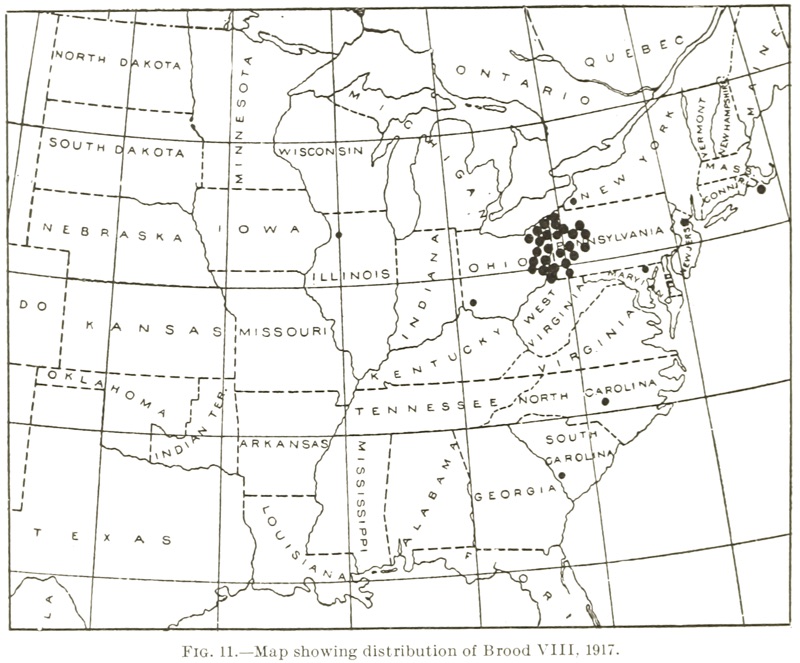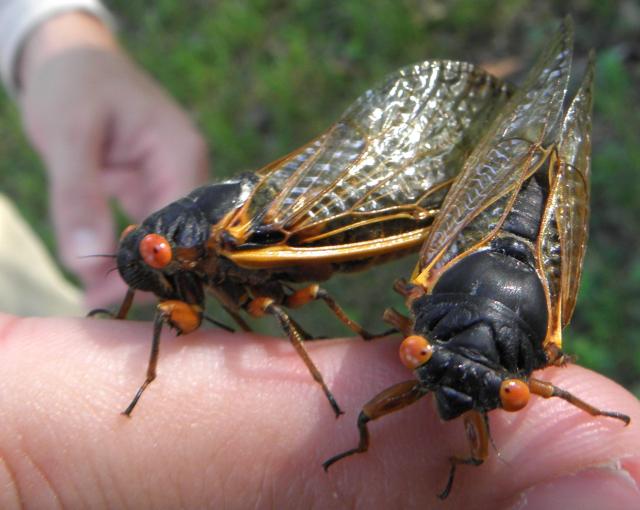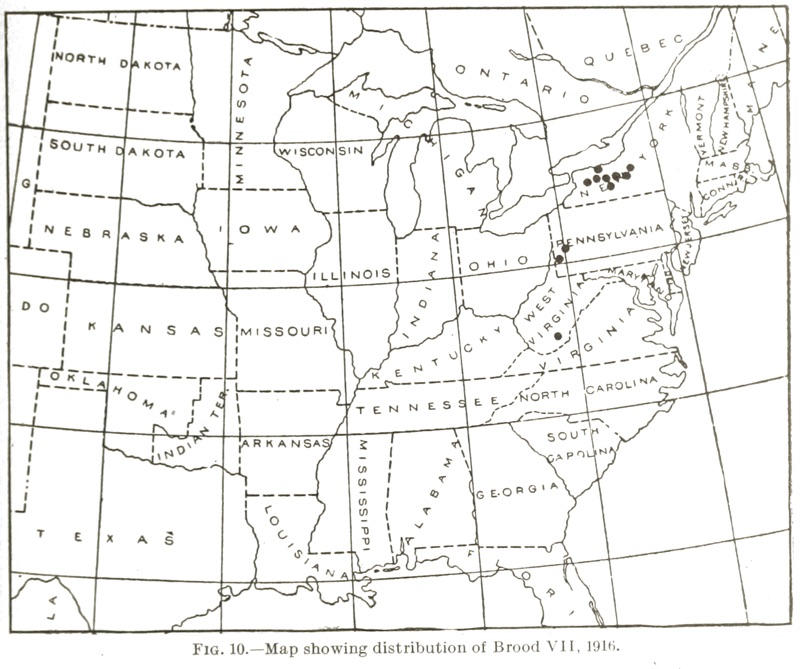Brood VIII will next emerge in 2036.
Periodical cicada Brood VIII (Eight) has emerged in 2019 in western Pennsylvania, eastern Ohio, and the tip of the northern panhandle of West Virginia, as well as Oklahoma (which was unexpected). The last time this brood emerged was in 2002.
- Look out for browning of leaves aka “flagging”, and in about a month, look for tiny cicada nymphs on branches where eggs were laid. You can still use the Cicada Safari App to report Flagging. It is available for iPhones/iOS and Android phones.
- If you’re on Facebook, there’s a Brood VIII Group for discussion.
- Read about my trip to see Brood VIII
What, when, where, and why:
What:
- Millions of these:
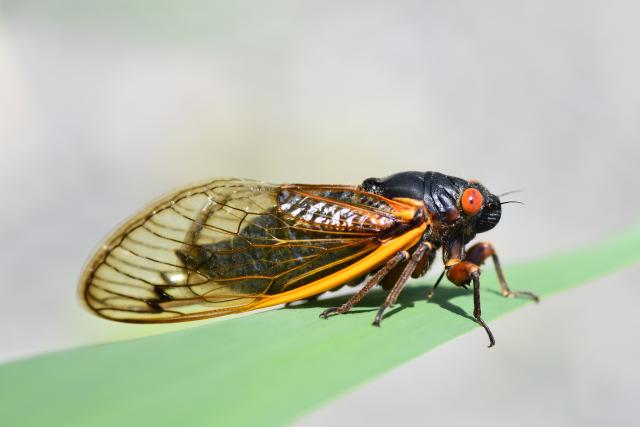
- Cicada insects with a 17-year life cycle.
- Some people call them “locusts” but they’re really cicadas.
- Which species: All three 17-year species, Magicicada septendecim, Magicicada cassini and Magicicada septendecula. How to tell the difference between the species.
- NOT the green ones that arrive annually.
When: Typically beginning in mid-May and ending in late June. These cicadas will begin to emerge approximately when the soil 8" beneath the ground reaches 64 degrees Fahrenheit. A nice, warm rain will often trigger an emergence.
Other tips: these cicadas will emerge after the trees have grown leaves, and, by my own observation, around the same time Iris flowers bloom.
Where:
Cicadas @ UCONN has the most up to date maps, including this modernized Google map.
You can report cicada sightings using the Cicada Safari App, available for iPhones/iOS and Android phones. The app helps you identify periodical cicada species, take photos and add your findings to a map.
- Pennsylvania Counties: Allegheny, Armstrong, Beaver, Butler, Clarion, Indiana, Lawrence, Venango, Washington, Westmoreland.
- Pennsylvania Cities: Aliquippa, Allegheny Township, Apollo, Baden, Beaver, Belle Vernon, Bethel Township, Black Lick, Blairsville, Bolivar, Brush Valley Township, Burgettstown, Center Township, Cheswick, Chippewa, Cranberry, Derry Township, Economy Boro, Elizabeth, Ellwood City, Fawn Township, Finleyville, Freedom, Gilpin, Greensburg, Harmony, Hempfield Township, Home, Homer City, Hopewell, Indiana, Leet Township, Ligonier, Midland, Murrysville, Natrona Heights, New Alexandria, New Brighton, New Florence, Parks Township, Pittsburgh, Rayne Township, Rector, Robinson Township, Rochester, Round Hill Park, Sewickley, Shelocta, St Clair Township, Stahlstown, Unity, Washington Township, West Deer, West Wheatfield Township, White Township, and more.
- Pennsylvania parks: Keystone State Park, Blue Spruce Park, Boyce Park, Crooked Creek Horse Park, Hoodlebug Trail, Pine Ridge Park, Yellow Creek State Park
- Ohio Counties: Columbiana, Mahoning. Trumbull, Ashtabula.
- Ohio Cities: Boardman, Calcutta, East Liverpool, Girard, Glenmoor, Lisbon, Mineral Ridge, New Waterford, Toronto, Wellsville, Youngstown, and more.
- West Virginia Counties: Hancock
- West Virginia Cities: Weirton, and more.
- West Virginia parks: Tomlinson Run State Park
- Oklahoma: Around Lawton, and north of Tulsa. Read this article.
More Location Tips:
- City data comes from 2002 reports.
- Brood VIII does overlap with Brood V (which emerged 3 years ago in 2016). Most of Brood VIII is east of V.
- As a general rule, if you experienced Brood V in 2016, or did not experience Brood VIII in 2002, you won’t experience them this year.
- Not sure? Ask someone in your community who lived there 17 years ago.
Visually, the cities mentioned above look like this: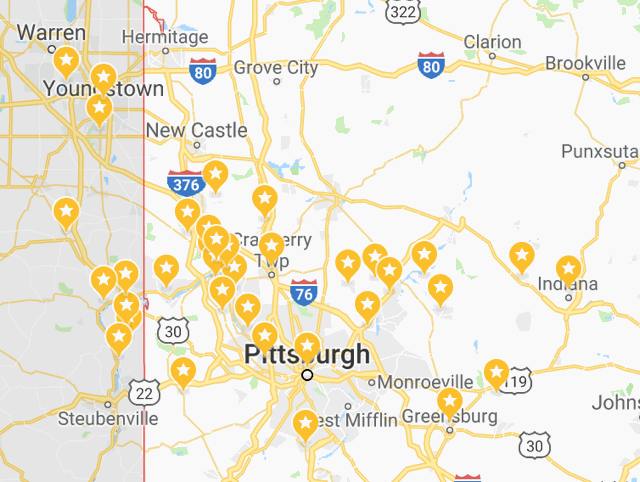
Why: Why do they emerge in massive numbers every 17-years? In a nutshell, the long life cycle has helped them avoid gaining a specific above-ground predator, and the massive numbers allow them to satiate predators in general, allowing enough to survive and reproduce.
Bonus content:
Video of newly emerged periodical cicada nymphs:
Magicicada cicada nymph mania from Cicada Mania on Vimeo.
More facts and fun:
- Use the correct image when talking about these cicadas
- Use the Periodical Cicada Emergence Checklist for the Maximum Magicicada Experience
- All cicada questions that are frequently asked.
- A video to help you tell the difference between the species
- The 17 Most Interesting Periodical cicada facts
1907 Map from Marlatt, C.L.. 1907. The periodical cicada. Washington, D.C. : U.S. Dept. of Agriculture, Bureau of Entomology.
